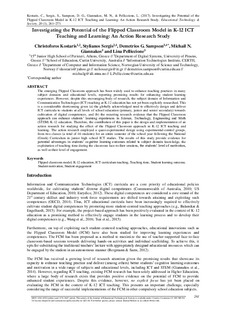| dc.contributor.author | Kostaris, Christoforos | |
| dc.contributor.author | Stylianos, Sergis | |
| dc.contributor.author | Sampson, Demetrios G. | |
| dc.contributor.author | Giannakos, Michail | |
| dc.contributor.author | Pelliccione, Lina | |
| dc.date.accessioned | 2018-01-23T12:31:11Z | |
| dc.date.available | 2018-01-23T12:31:11Z | |
| dc.date.created | 2017-01-05T14:52:15Z | |
| dc.date.issued | 2017 | |
| dc.identifier.citation | Educational Technology & Society. 2017, 20 (1), 261-273. | nb_NO |
| dc.identifier.issn | 1436-4522 | |
| dc.identifier.uri | http://hdl.handle.net/11250/2479079 | |
| dc.description.abstract | The emerging Flipped Classroom approach has been widely used to enhance teaching practices in many subject domains and educational levels, reporting promising results for enhancing student learning experiences. However, despite this encouraging body of research, the subject domain of Information and Communication Technologies (ICT) teaching at K-12 education has not yet been explicitly researched. This is a considerable shortcoming given (a) the globally acknowledged need to effectively design and deliver ICT curricula to students at all levels of school education (primary, junior and senior secondary) towards cultivation of digital competences, and (b) the recurring research evidence that the Flipped Classroom approach can enhance students' learning experiences in Science, Technology, Engineering and Math (STEM) K-12 education. Therefore, the contribution of this paper is the design and implementation of an action research for studying the effect of the Flipped Classroom approach in K-12 ICT teaching and learning. The action research employed a quasi-experimental design using experimental-control groups, from two classes (a total of 46 students) for an entire semester of the school year following the National (Greek) Curriculum in junior high school ICT studies. The results of this study provide evidence for potential advantages in students' cognitive learning outcomes related to subject domain knowledge, the exploitation of teaching time during the classroom face-to-face sessions, the students' level of motivation, as well as their level of engagement. | nb_NO |
| dc.language.iso | eng | nb_NO |
| dc.publisher | International Forum of Educational Technology and Society - | nb_NO |
| dc.relation.uri | http://ifets.info/journals/20_1/23.pdf | |
| dc.rights | Attribution-NonCommercial-NoDerivatives 4.0 Internasjonal | * |
| dc.rights.uri | http://creativecommons.org/licenses/by-nc-nd/4.0/deed.no | * |
| dc.title | Investigating the potential of the flipped classroom model in K-12 ICT teaching and learning: An action research study | nb_NO |
| dc.type | Journal article | nb_NO |
| dc.type | Peer reviewed | nb_NO |
| dc.description.version | publishedVersion | nb_NO |
| dc.source.pagenumber | 261-273 | nb_NO |
| dc.source.volume | 20 | nb_NO |
| dc.source.journal | Educational Technology & Society | nb_NO |
| dc.source.issue | 1 | nb_NO |
| dc.identifier.cristin | 1421800 | |
| dc.description.localcode | This article of the Journal of Educational Technology & Society is available under Creative Commons CC-BY-ND-NC 3.0 license (https://creativecommons.org/licenses/by-nc-nd/3.0/). | nb_NO |
| cristin.unitcode | 194,63,10,0 | |
| cristin.unitname | Institutt for datateknologi og informatikk | |
| cristin.ispublished | true | |
| cristin.fulltext | original | |
| cristin.qualitycode | 1 | |

